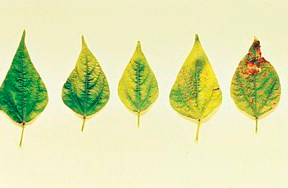
Zinc (Zn) is a nutritive microelement for plants (along with Fe, Mn, Cu, B, Mo, Cl and Ni) due to its low concentration in which it is found in plant tissues, lower than 0.1 ‰. In this article, we will analyze the importance of this element for the nutrition and productivity of crops, as well as some key points for the detection of deficiencies in the plant.
Zinc (Zn):
Zinc plays a very important role as a stabilizer of the chlorophyll molecule, hence symptoms of deficiency of this element are manifested as interveinal chlorosis of leaves, generally in the middle layer of the plant, this due to the medium mobility of the element. Zinc is necessary for the activity of at least eighty enzyme systems (normally forming part of its structure, although it does not undergo changes in its oxidation state), for example, NADH-dehydrogenase, alcohol-dehydrogenase, which catalyzes the step from acetaldehyde to ethanol in alcoholic fermentation, and the five carbonic anhydrases, described so far, that accelerate the reversible hydration of carbon dioxide to bicarbonate in photosynthesis (Bonilla, 2008).

Zinc is an element that is better absorbed through the roots, in the soil or substrate at acidic pH, at neutral to alkaline pH, its use is difficult, very similar to what happens with Iron (Fe). It is absorbed in the form of a divalent Zn2 + cation, and better as a Zinc chelate.
Another characteristic symptom of Zinc deficiency in plants is growth disturbance. In plants with Zinc deficiency, cell division stops; beading, plants with dwarfism, atrophy, the internodes are generally small and the leaves do not develop their foliar area in a normal way, giving rise to symptoms known as mouse ear. The above is related to the participation of Zinc in the synthesis of Indolacetic Acid (IAA), an auxin-type phytohormone that plays an important role in cell division.

Zinc can be supplied through formulations based on Zinc Chelates, which make it very stable and assimilable by the plant, through roots and leaves. Its application is important during the first stages of the culture for the correct cell division and supply in tissues.
Consulted Bibliography:
Bonilla, I. 2008. Fundamentos de fisiología Vegetal. 1ª ed. Editado por AZÓN-BIETO, J., TALÓN M. En español. PUBLICACIONS I EDICIONS DE LA UNIVERSITAT DE BARCELONA. Barcelona, España. 651 pp.

